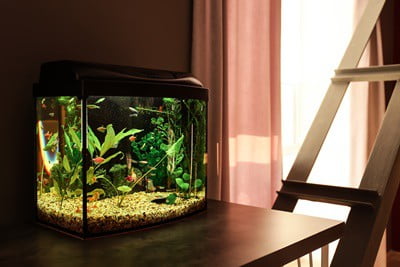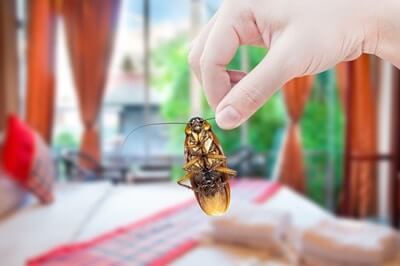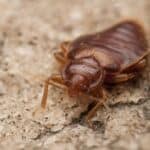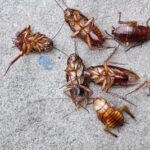It can be concerning to see cockroaches emerge from underneath your aquarium’s lid. Roaches are covered in bacteria (and sometimes insecticides), so it’s important to keep them away from your pet fish. That starts by understanding why cockroaches are drawn to aquariums.
Cockroaches like fish tanks because they make ideal habitats. Aquariums are moist, humid, and offer a water source. Fish tanks also contain a lot of waste, such as poop, algae, and leftover food. Roaches can hide in the cords, heater, and filter of the tank. They can even stay warm in the electronic equipment, such as the heater or filter.
While fish can eat roaches, as long as they’re small enough, this is harmful. Roaches may affect the digestion of fish or poison them with leftover insecticide. That’s why you should never use insecticide dust, powder, or sprays around your fish tank. Instead, move it away from where the roaches are nesting, clean it, and then seal it from outside access.
Why Are There Cockroaches Around Fish Tank?
A fish tank will not be a roach’s first choice. These insects much prefer more open access to food and water, such as the kind found in kitchens and bathrooms. However, if the rest of your home is meticulously cleaned or your fish tank falls into disrepair, roaches will seek it out. Cockroaches are attracted to fish tanks due to:
- Moisture
- Heat
- Hiding places
- Leftover fish food
- A build-up of waste
Moisture
A fish tank is a prime source of moisture for a cockroach. Ideally, a fish tank will not leak and will remain carefully sealed. This will leave the area around it dry and clean. However, accidents do happen. These include:
- Your fish tank may have a crack, which causes a leak
- As you clean the tank, water may splash onto the surrounding area
- If the water levels are low, your filter may struggle and sputter to work. This splashes water out of the tank
- The filter itself is a prime moist area for roaches to investigate
Roaches will use this as a water source and a tepid environment. Even a warm house can get cooler when you’re near a humid fish tank.
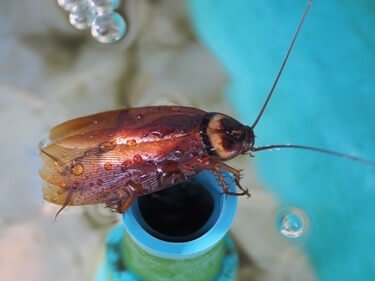
Heat
In that vein, roaches like heat. Your fish tank will have many electronics attached to it that will generate warmth. This may include your:
- Heater
- Lights
- Filter or pump
- Air stone and its connecting wires
They may stay near these machines for warmth. If your home gets chilly during wintertime, the pests may be using your aquarium to stay warm.
Hiding Places
Roaches are adept at hiding, and fish tanks offer many nooks and crannies. Roaches may be nestled in:
- The wiring and cords that surround your fish tank
- In the stand or cabinet that your fish tank sits on
- In the filter
- Under the hood of the tank
- Behind the tank, in the space between it and the wall that it’s placed against
Since these places won’t be investigated often, roaches can hide here unperturbed. They may even be able to feed on the dust or stray crumbs that pile up here, ignored by your cleaning routine.
Leftover Fish Food
Roaches can use fish food as a way to stock up on energy and survive. As you feed your aquarium fish, you may:
- Sprinkle food around the tank by accident.
- Leave the food container open next to the tank.
- Accidentally leave traces of fish food along the lip of the tank or under the hood.
- Let food accumulate on the water’s surface, leaving it behind when fish don’t eat it.
Cockroaches will clean up these leftovers for you. In exchange, they only ask to infest your house and demand more food over time. A roach population can quickly grow when given this open food source.
According to the Allergology Department of the Hospital Clinic University of Spain, fish food often contains trace ingredients from arthropods, much like cockroaches. That’s usually noticed when it comes to allergies. People who are allergic to cockroaches may also experience a bad reaction to fish food. However, roaches have no issue eating food that’s made of their evolutionary cousins.
Waste Build-Up
Even a well-maintained aquarium has waste. Roaches will use this as a source of food, munching on:
- The calcium build-up around the corners of the tank
- The fish waste that collects in the filter or around the edges of the hood
- The algae growth that may climb up to the edges of the tank
That makes it important to keep your tank as spotless as you can. Not only is this healthier for the fish, but it will keep other bugs from taking advantage.
Where Do Roaches Hide In Fish Tanks?
If you’ve seen one cockroach run away from your aquarium, you don’t need to worry. It’s possible the creature was en route to another hiding place. However, it may also be nesting around your tank. Roaches will always nest in hidden, dark, moist areas. As such, here are the best places to check for roaches in your aquarium:
- The corners of the tank
- Behind the tank
- Underneath the hood
- Around and under the cording
- In the filter
- In the cabinet or stand
- On the floor around the tank, usually in a corner
- Wherever you store the fish food
- In the baseboards or wall molding near the aquarium
Even if there are no roaches present at the moment, there could be an infestation. Here are the signs to look for:
- Droppings. These droppings should be small, brown, and cylindrical.
- Shed exoskeletons. The exoskeleton of roaches will look like dead roaches but be thin and mildly transparent.
- More than 3 roaches. Roaches don’t hunt for food in packs, but they do nest together. If you see 3 or more roaches, you may have a nest.
- Egg sacs. Roaches may place egg sacs near their hideout. You’ll see small, white clusters stuck to and underneath things.
Roaches in Fish Tank Filter
The worst place to find cockroaches is in your tank’s filter. Unfortunately, this will be the favorite spot of cockroaches. That’s because filters are:
- Filters are warm. Roaches will use this to stay warm and reproduce.
- Filters cycle water through them but aren’t always submerged. This gives the roach a chance to get water without falling into the tank, where the roach could drown.
- Filter sponges are food sources. Depending on the design, roaches may eat the fiber itself and the waste collected in it.
- Filters can be hiding spaces. Depending on how large your filter is, roaches may enter through the back and hide in the base. This will be away from the moving parts and water.
- Filters have a build-up of waste. If you don’t change the filter regularly, roaches may feed on fish waste and algae.
Unfortunately, the longer roaches stay in the filter, the more damage they can do. The pests may end up:
- Clogging the filter with their bodies or droppings
- Eat through wiring, even causing an electrical fire
- Lay eggs in the filter, which may lead to baby roaches getting dumped into the tank
- Leave behind bacteria and filth that can infect the aquarium
While this won’t be immediately damaging to your tank, it can become dangerous over time. If you suspect roaches are hiding around your tank, be sure to check your filter right away.
Do Fish Tanks Attract Bugs?
Having a fish tank will not make your home more prone to bug infestations. However, if your aquarium is poorly maintained, it will have all the key ingredients needed to attract bugs.
As mentioned, it provides ample hiding spots, warmth, food, and moisture. If you’re dealing with a bug problem, consider cleaning your tank more often. You should clean the tank every 2 weeks:
- Regularly change out the filter when it appears to be full
- Change out any collection cups as they’re filled
- Clean the surrounding area of food or spilled water
- Check if algae are building up around the lip of your tank
Can Fish Eat Roaches?
While fish aren’t a natural predator, some can eat roaches. As long as the insect is smaller than the fish, it can be eaten whole. However, this can be dangerous for your fish. Household roaches, unlike wild breeds, are more commonly exposed to:
- Bacteria
- Toxins
- Insecticides
Roaches may be coated in these harmful substances, which your fish will ingest as a byproduct. That could lead to digestive issues, poisoning, and even death. Smaller fish are less likely to eat the roaches. However, they may still pick at the roach and pull off legs or wings.
Since roaches cannot swim, they will fall into the tank while they try to scavenge on leftover food or algae. In this event, they will close up their spiracles and begin to float. At this time, they will spread bacteria into the water. This will be a small amount, ignorable by most fish. However, if you have fish that are sickly, their immune system may get compromised.
As such, if you spot a roach in your tank, be sure to remove it. Once a fish has eaten a roach, you cannot make the fish spit it back up. You will have to wait and see if it develops an illness.
Can You Feed Cockroaches To Fish?
With that said, some types of cockroaches are safe for fish. These are not the average kind found around your household. Instead, dubia roaches can be bought in pet stores. These are commonly known as orange-spotted orange, which belongs to the family of Blaberidae.
These types of roaches contain high levels of protein, minerals, and calcium. Fish can benefit from eating these roaches live or frozen. This species is farmed as pet food, so you can be sure they’re not coated in bacteria or insecticides. Sadly, that does mean you can’t safely dispose of your household roaches.
How To Keep Roaches Away From Fish Tanks
If you have roaches near your tank, you should proceed carefully. Insecticide can be deadly for fish. According to the Journal of Applied Zoology, poisons used against cockroaches, in particular, may kill off all the inhabitants of your tank. That’s especially true for insecticides that contain:
- Diazinon
- Pyrethrum
- Piperonyl butoxide
- Dieldrin
- BHC (lindane)
These are common ingredients found in bug bombs, anti-roach spray, and roach powder. The obvious answer is to put insecticides around the tank, not in it. Then the roaches will be poisoned long before they reach your fish. However, this still poses dangers.
Roach bait traps and anti-roach powder often rely on the cockroaches carrying the poison with them. This ensures they’re exposed to it for longer, making it more effective. They may also bring it back to their colony, poisoning more than one bug with each trap. However, the roaches may also scurry around the edges of your tank or walk through the aquarium filter. This will introduce the deadly poison to your fish.
When you have a fish tank, you need to be more careful of poisoning roaches than ever before. Here’s the best way to proceed:
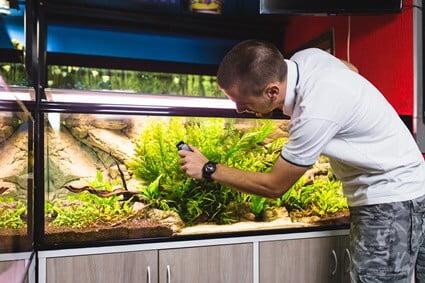
Isolate The Tank
If you have an infested tank, remove the aquarium from that area. This will involve dismantling all the gear, cords, and hood. They should be moved to a different area, free of the roaches. This will help disrupt the cockroaches’ hiding place and make them struggle to find the tank again.
Clean the Tank
Of course, it won’t take roaches long to relocate their favorite home. In the grace period that moving that tank buys you, be sure to clean it thoroughly. The aquarium will already be dismantled, so be sure to use a fish-safe cleaning solution on the:
- Filter
- Cords
- Lights
- Hood
- Cabinet that the tank sits on
- Outside of the tank
This will remove bacteria and scent trails left by the roaches. Ensure the entire collection of gear is dried, free of leftover food, and has any deposits of calcium or algae removed. This will help limit the attractiveness of the tank to pests. Even if they find it again, they’re less likely to stay there.
Remove Access To Fish Food
You should change your feeding routine. Any food that your fish do not eat within 2-3 minutes should be removed. Not only will it disrupt the chemical balance of the tank if left behind. Roaches can scavenge it.
Cover Entry Points
You will need to protect the fish as you handle the roach problem. Be sure to check over the tank’s hood for any gaps or crevices a roach could sneak in through. If your tank doesn’t have a lid, be sure to invest in one now.
Check the filter to see if there are any points of entry. You may need to create a lid or cover for the filter, so roaches can’t sneak into the back. This can be done with a piece of plastic or cardboard. It should be loose fitting around the top so it doesn’t harm the filter’s ability to work. However, it should be tightly sealed around the base, so roaches can’t sneak in.
Roaches can and will still find new ways in, if given time. That’s why you need to eliminate them before they can.
Apply Pest Control Methods
Now that your tank is isolated, you can use insecticides on the roaches. Be sure that these are:
- Dust or powder
- Baited roach traps
According to the Journal of Economic Entomology, gel, powder, and pheromone baits can lure in roaches. Some will even kill the roach on the spot. These will be ideal for your situation. If the roaches do manage to escape, they will be unable to access your fish. The filter cover or tank lid will keep them from spreading the poison.
Cockroaches are attracted to fish tanks. The key is to separate the roaches from aquariums in the period where you take steps to get rid of them from your home.
